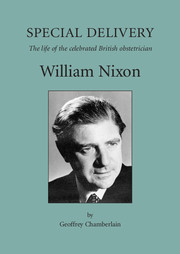Book contents
- Frontmatter
- Contents
- Foreword
- Preface
- Introduction
- Acknowledgements
- Chapter One Early Days (1903–1918)
- Chapter Two The Medical Student (1922–1927)
- Chapter Three Postgraduate Training (1927–1934)
- Chapter Four Consultancies: at Home and Away (1935–1939)
- Chapter Five The War Years (1939–1945)
- Chapter Six The Obstetric Unit in Nixon's Time (1946–1966)
- Chapter Seven Research in the Obstetric Unit (1946–1956)
- Chapter Eight Teaching at UCH (1946–1966)
- Chapter Nine Nixon the Man (1928–1965)
- Chapter Ten Last Days
- APPENDICES
- SOURCES
- INDEX
Chapter Eight - Teaching at UCH (1946–1966)
Published online by Cambridge University Press: 05 February 2014
- Frontmatter
- Contents
- Foreword
- Preface
- Introduction
- Acknowledgements
- Chapter One Early Days (1903–1918)
- Chapter Two The Medical Student (1922–1927)
- Chapter Three Postgraduate Training (1927–1934)
- Chapter Four Consultancies: at Home and Away (1935–1939)
- Chapter Five The War Years (1939–1945)
- Chapter Six The Obstetric Unit in Nixon's Time (1946–1966)
- Chapter Seven Research in the Obstetric Unit (1946–1956)
- Chapter Eight Teaching at UCH (1946–1966)
- Chapter Nine Nixon the Man (1928–1965)
- Chapter Ten Last Days
- APPENDICES
- SOURCES
- INDEX
Summary
I have spread my dreams under your feet;
Tread softly because you tread on my dreams.
He Wishes for the Cloths of Heaven (1899) WB YeatsThe term ‘doctor’ comes from the old French doctour, which itself is derived from docere, the Latin: to teach. For centuries, the art and craft of medicine had been transmitted in an apprentice fashion from senior doctor to junior medical student and so it became the accepted style that doctors taught their juniors. Until the early nineteenth century there were only three universities in England (Oxford, Cambridge and Durham) and they did not bother much with medicine as an academic subject. Then, in a flood in the nineteenth century, many more universities were established, chairs were created in various major disciplines and the teaching of medicine to the undergraduates tended to move under their influence. A university tradition entered medical education, which was then forced into a pattern of lectures and practical classes equivalent in the minds of university administrators to laboratory sessions. Medicine did not fit perfectly as a university subject but only in the last twenty years has it escaped from this mould and now is becoming once more a separate discipline.
After qualifying, the medical teaching of junior doctors is not continued at university level in the UK but left in the hands of the various Royal Colleges.
- Type
- Chapter
- Information
- Special DeliveryThe Life of the Celebrated British Obstetrician, William Nixon, pp. 95 - 108Publisher: Cambridge University PressPrint publication year: 2004

